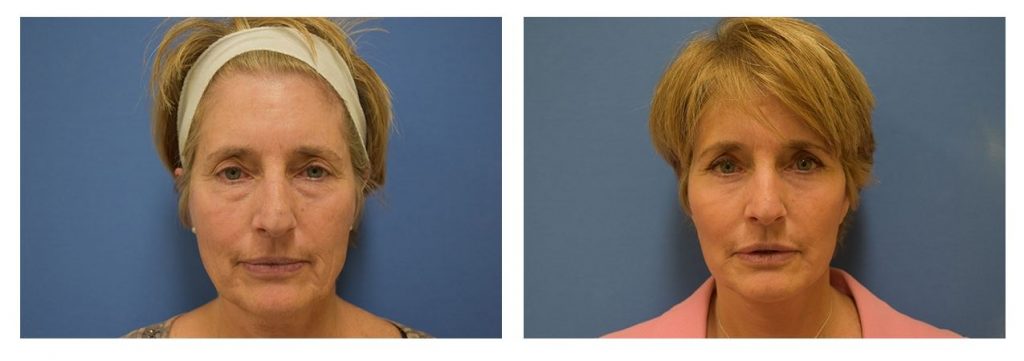FACIAL REJUVENATION AT AW PLASTIC SURGERY
Every face—like every individual—is unique. That’s why there’s no “one size fits all” approach to facelift surgery. The aging process affects each of us differently, creating the need for personalized surgical rejuvenation. Board-certified plastic surgeon Dr. Anthony Wilson therefore takes a comprehensive approach to each facelift he performs: Through combining surgical and nonsurgical techniques, he can create subtle, graceful results that work in harmony to enhance your distinctive features.
HOW FACELIFT SURGERY WORKS
In the past, facelift surgery involved the tightening of loose skin. The patient’s skin was pulled firm over the underlying bones, then excess skin was carefully removed. While this process effectively eliminated wrinkles, jowls, and other signs of aging, it tended to produce a “windswept” look. The results of past techniques in facelift surgery were also relatively short-lived; because facial skin stretches fairly easily, this type of facelift needed to be repeated every five to seven years.
Over the last decade, the surgical approaches to a facelift have improved tremendously. Modern facelift methods correct the signs of aging where they start, in the superficial muscular aponeurotic system (SMAS). Adjusting the muscles that support the face can raise and refine a patient’s features without distorting them. This technique also produces very long-lasting results; most patients enjoy the results of their SMAS facelift for ten to fifteen years.
During facelift surgery, incisions are made along the patient’s hairline and around his or her ears. (Placing incisions in these areas creates little visible scarring, as scars are hidden by the patient’s hair and ear folds.) Dr. Wilson then repositions the patient’s deeper tissues, simultaneously raising facial fat pads and the connective tissues that support the skin.
Once these supportive tissues are fastened in place with self-dissolving sutures, Dr. Wilson carefully drapes the skin over the patient’s face, creating a naturally smooth appearance. Excess skin is removed, but the skin is not pulled artificially tight at any time during this process, so it will remain supple and elastic after surgery. Facelift patients can expect to enjoy a youthful, refreshed, and defined appearance.
FACELIFT OPTIONS AND COMPLEMENTARY PROCEDURES
One of the primary advantages of modern facelift surgery is its flexibility; it can be completely tailored to each patient. Patients can choose to have full facial rejuvenation or even a “mini” facelift for moderate aging.
-
FULL FACE REJUVENATION
Dr. Wilson can combine standard SMAS lift techniques with a neck lift and/or eyelid surgery (blepharoplasty). This is generally recommended for mature patients who exhibit a higher degree of skin laxity. Lifting the skin on the neck and contouring the eyelids creates much more transformative results for these patients than a facelift alone.
Facial fat grafting is also frequently performed for patients interested in full face rejuvenation. To perform facial fat grafting, Dr. Wilson uses liposuction to harvest a small amount of fat from the patient’s body. This fat is then processed in a centrifuge and injected into precise locations of the face, where it fills in hollows around the eyes and cheekbones. This gives the patient’s face a fuller, more youthful appearance.
-
MINI FACELIFT SURGERY
Mini facelift surgery is most appropriate for younger patients with moderate aging. Mini facelift surgery requires just two short incisions around the patient’s ears and is therefore associated with reduced scarring and healing time. These incision sites allow Dr. Wilson to access the SMAS and make adjustments, but they do not permit the removal of excess skin. Mini facelift procedures are generally performed without general anesthesia.
-
COMPLEMENTARY NONSURGICAL PROCEDURES
Patients who elect to have mini facelift surgery, or a standard SMAS lift without facial fat grafting, may benefit from injectable treatments like Botox®, Juvéderm®, and Restylane®. Neuromodulators like Botox® can smooth the patient’s forehead and orbital region, erasing crow’s feet and frown lines. Dermal fillers, on the other hand, can be used in place of facial fat transfer to fill in deep lines and hollows.
Though facelift surgery effectively addresses the structural aspects of facial aging, it does not correct the superficial signs of aging, such as discoloration or variations in skin texture. For this, you will need to consider other aesthetic treatments. Dr. Wilson frequently recommends IPL Photofacial therapy or dermal peels for the treatment of age spots, fine lines, and areas of dull or rough skin on the face.
Dr. Wilson can combine standard SMAS lift techniques with a neck lift and/or eyelid surgery (blepharoplasty). This is generally recommended for mature patients who exhibit a higher degree of skin laxity. Lifting the skin on the neck and contouring the eyelids creates much more transformative results for these patients than a facelift alone.
Facial fat grafting is also frequently performed for patients interested in full face rejuvenation. To perform facial fat grafting, Dr. Wilson uses liposuction to harvest a small amount of fat from the patient’s body. This fat is then processed in a centrifuge and injected into precise locations of the face, where it fills in hollows around the eyes and cheekbones. This gives the patient’s face a fuller, more youthful appearance.
Mini facelift surgery is most appropriate for younger patients with moderate aging. Mini facelift surgery requires just two short incisions around the patient’s ears and is therefore associated with reduced scarring and healing time. These incision sites allow Dr. Wilson to access the SMAS and make adjustments, but they do not permit the removal of excess skin. Mini facelift procedures are generally performed without general anesthesia.
Patients who elect to have mini facelift surgery, or a standard SMAS lift without facial fat grafting, may benefit from injectable treatments like Botox®, Juvéderm®, and Restylane®. Neuromodulators like Botox® can smooth the patient’s forehead and orbital region, erasing crow’s feet and frown lines. Dermal fillers, on the other hand, can be used in place of facial fat transfer to fill in deep lines and hollows.
Though facelift surgery effectively addresses the structural aspects of facial aging, it does not correct the superficial signs of aging, such as discoloration or variations in skin texture. For this, you will need to consider other aesthetic treatments. Dr. Wilson frequently recommends IPL Photofacial therapy or dermal peels for the treatment of age spots, fine lines, and areas of dull or rough skin on the face.
WHAT TO EXPECT DURING FACELIFT RECOVERY
Recovery time varies depending on the type of facelift you have. Patients who have a standard facelift generally need to rest in bed for three to five days after their surgery, then they can resume light activity. Most patients choose to take at least two weeks off of work, because symptoms of swelling and bruising can last for up to 14 days.
Patients who have mini facelift surgery usually only need to rest in bed for 24 to 48 hours, and they can return to work within seven to ten days. All forms of facelift surgery take a while to fully “settle.” The facial support and skin gradually adjust to their new position over a period of six months to one year. Patients can therefore expect their initial results to improve further with time.
WHO MAKES A GOOD CANDIDATE FOR FACELIFT SURGERY?
Candidates must be in good overall health and be current nonsmokers. Facelift surgery is also best suited to patients who have at least some skin laxity. Patients under 40 who have very minimal skin laxity might wish to consider a “liquid facelift” instead. During a liquid facelift, completely noninvasive injectable treatments are used to subtly lift the soft tissues and minimize the appearance of creases.
Schedule a Consultation
From Breast Augmentation to Non-Surgical Rhinoplasty and everything in-between, Board-Certified plastic surgeon Anthony Wilson, MD, FACS offers a wide range of procedures at his Portsmouth, NH office. If you are interested in booking a procedure, take the next step by scheduling a consultation today.
ARRANGE A FACELIFT CONSULTATION IN PORTSMOUTH
Aging gracefully is a universal and worthwhile goal. If you’re ready to pursue facial rejuvenation and reduce the visible signs of aging, the dedicated team at AW Plastic Surgery can help. Contact board-certified plastic surgeon Dr. Anthony Wilson at (603) 294-4526 to begin the facelift consultation process today. Dr. Wilson will be happy to answer any questions you have about this versatile, transformative procedure.
QUESTIONS AND ANSWERS ABOUT FACELIFT SURGERY
If you have sagging skin on your face that doesn’t improve with creams, serums, or non-surgical treatments like FaceTite, microneedling, or Botox®, a facelift is the only way to restore a more youthful look. A facelift can remove drooping jowls and “marionette lines” between the nose and mouth.
If you are under 40 and have only mildly loose skin on your face, it may be better to consider non-surgical treatments first. Once skin begins to sag more noticeably, which typically happens in your 40s, 50s, and 60s, a facelift is probably the solution. If you are in good health, you can have plastic surgery into your 80s.
Incisions for a facelift are carefully placed where they will not be noticeable — along your hairline and in the crease of your ears. When an incision on the chin is needed, it is placed along the natural creases below your chin where it becomes almost invisible after healing. Scars may be more noticeable in the first three to six months after surgery before they fade. During this time, makeup can be used to hide them.
You will see the changes from the surgery right away, though you will experience some swelling and bruising in the 2 weeks after surgery. Most patients are comfortable returning to work and social activities after 10 days to 2 weeks. By 2 to 3 months after the procedure, you can expect to look and feel great. Your face will look as much as ten years younger. If you are planning to attend an important event — like a wedding or class reunion — it’s best to schedule your facelift at least 2 months before.
You can expect to have some numbness in the skin of your cheeks and neck after the procedure. Normal feeling usually returns in 6 to 12 weeks. Some lingering numbness can last for a few more months.
Most patients find that they look 7 to 15 years younger after a facelift, though your results will depend on the condition of your face before the procedure and the specifics of the surgery performed. In your consultation with Dr. Wilson, it can be helpful to bring in photographs of yourself from 10 years earlier. Those can help him plan the procedure. His goal will be to make you look like a naturally younger version of yourself, and not to change the way you look.
A facelift will set the clock back on your appearance and will continue to make you look younger as you age. After about 15 years for a full facelift, or 4 to 6 years for mini facelift, you may choose to have another one performed to give yourself a freshly rejuvenated look.
Meet Dr. Wilson
Anthony Wilson, MD, FACS has vast experience performing facial, body, and reconstructive procedures. After receiving an undergraduate degree from Harvard University and completing training with a medical degree from the University of Pennsylvania, Dr. Wilson has continued to improve his technique to ensure the best results possible. Learn More about Anthony Wilson, MD, FACS and why you should choose the Board-Certified plastic surgeon for your next procedure in the Seacoast Region.

